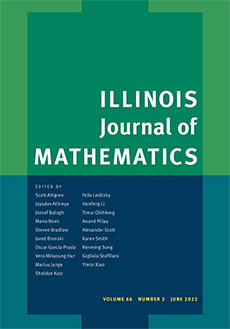Abstract
Let $(n_k)_{k \geq1}$ be a lacunary sequence, i.e., a sequence of positive integers satisfying the Hadamard gap condition $n_{k+1}/ n_k \ge q >1, k \geq1$. By a classical result of Philipp (Acta Arith. 26 (1975) 241-251), the discrepancy $D_N$ of $(n_k x)_{k\ge1}$ mod 1 satisfies the law of the iterated logarithm, i.e., we have $1/(4 \sqrt{2}) \leq\limsup_{N \to\infty} N D_N(n_k x) (2 N \log\log N)^{-1/2} \leq C_q$ for almost all $x \in(0,1)$, where $C_q$ is a constant depending on $q$. Recently, Fukuyama computed the exact value of the $\limsup$ for $n_k=\theta^k$, where $\theta>1$, not necessarily an integer, and the author showed that for a large class of lacunary sequences the value of the $\limsup$ is the same as in the case of { i.i.d.} random variables. In the sublacunary case,\break the situation is much more complicated. Using methods of Berkes, Philipp and Tichy, we prove an exact law of the iterated logarithm for a large class of sublacunary growing sequences $(n_k)_{k \geq1}$, characterized in terms of the number of solutions of certain Diophantine equations, and show that the value of the $\limsup$ is the same as in the case of { i.i.d.} random variables.
Citation
Christoph Aistleitner. "Diophantine equations and the LIL for the discrepancy of sublacunary sequences." Illinois J. Math. 53 (3) 785 - 815, Fall 2009. https://doi.org/10.1215/ijm/1286212916
Information





